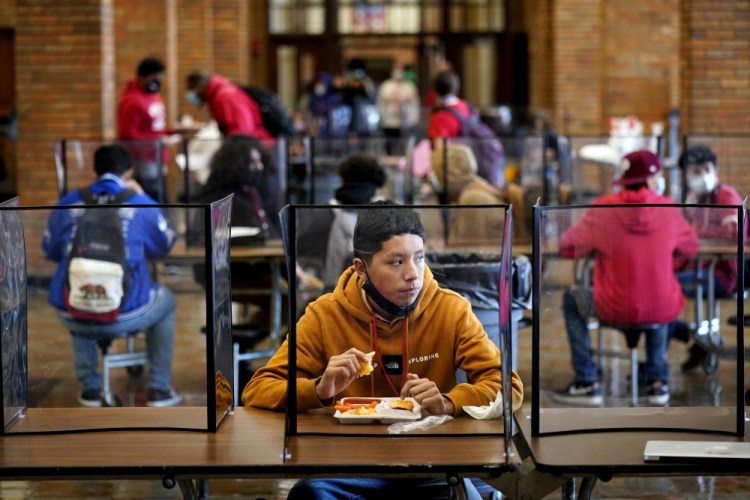With a massive infusion of federal aid coming their way, schools across the U.S. are weighing how to use the windfall to ease the harm of the pandemic – and to tackle problems that existed long before the coronavirus.
The assistance that was approved last month totals $123 billion – a staggering sum that will offer some districts several times the amount of federal education funding they receive in a single year. The aid will help schools reopen and expand summer programs to help students catch up on learning. It also offers a chance to pursue programs that have long been seen as too expensive, such as intensive tutoring, mental health services and major curriculum upgrades.
“This feels like a once-in-a-generation opportunity for us to be able to make critical investments,” said Nathan Kuder, chief financial officer of Boston Public Schools, which is expecting $275 million.
But the spending decisions carry high stakes. If important needs are overlooked – or if the money does not bring tangible improvements – schools could face blowback from their communities and from politicians who influence their funding. At the same time, schools must be wary of dreaming too big and taking on long-term costs they cannot sustain.
Education Secretary Miguel Cardona said the assistance allows schools to “hit the reset button” and confront challenges that have long plagued the nation’s education system. He said schools can train teachers in social and emotional learning and work to close persistent racial disparities in education.
“With successful implementation, our students are going to have a better experience than they did before the pandemic,” Cardona said in an interview.
Districts with higher concentrations of poverty will get the largest sums. Public schools in some cities are expected to receive more than $1 billion, including Los Angeles and Philadelphia. The new money joins more than $67 billion made available to schools in other relief packages during the pandemic.
Schools must reserve 20 percent for summer programs and other efforts to address learning loss, but they expect to have wide flexibility in how to use most of the aid. With more than three years to spend the new money, school leaders are thinking big.
Officials in Boston say the aid will be used to reopen, recover and “reimagine what is possible for our students,” Kuder said. The money will help update aging buildings, but it could also be used to start new dual-language programs or revamp the curriculum, he said. Ultimately, officials plan to ask residents what changes they want to see.
In Tulsa, Oklahoma, where 83 percent of students come from low-income families, the district expects to get $120 million – nearly three times the amount it gets in federal education funding in a typical year. Along with building upgrades, the aid will help achieve a goal to provide summer programs and after-school care in every neighborhood, officials said.
“We plan to use this moment to consider how we can bring about lasting change for our school district,” Superintendent Deborah Gist said.
School officials in Hartford, Connecticut, say they have lined up a list of “must-win” spending areas. Superintendent Leslie Torres-Rodriguez said the district plans to “radically expand” learning options outside the school day, cultivate a pipeline of new teachers and expand the role of schools in their communities.
The district also hopes to buy new curriculum materials across all grades and subjects, a goal that was previously out of reach. “It is something that we’ve never been able to do,” Torres-Rodriguez said. “All that we’ve been able to afford is a little bit here and a little bit there.”
Even though the funding brings a bonanza for some districts, questions loom around other sources of financial support. Some states have already slashed education budgets as they face steep revenue losses, and other states are likely to follow, which could diminish the effect of the federal dollars.
To keep future costs in check, many schools are avoiding big hiring increases, and few are pursuing programs that carry heavy personnel costs. Instead, many will consider adding teachers under short-term agreements or hiring contractors to provide social and mental health services.
In Virginia Beach, officials are weighing whether to add teachers under one-year contracts, with a focus on recruiting retirees or others outside the teaching profession. The district is also exploring whether to train current teachers in high-demand subjects and to add mental health services through a telehealth provider.
“It’s a substantial increase, but it’s important to understand that these are not ongoing funds,” Superintendent Aaron Spence said.
The top goal is to get students back in the classroom. In Detroit schools, which expect to receive $800 million, much of the aid will be used on ventilation systems and to pay the costs associated with smaller classes and social distancing. Some of it is expected to go toward hazard pay for teachers who return to the classroom.
And while the funding is largely intended to reverse the setbacks caused by a year of remote learning, there’s also a push to sustain virtual options. At Montgomery County Public Schools in Maryland, officials are expanding summer learning, but they also plan to start a virtual academy for students with health concerns and those who thrived under remote learning.
In Akron, Ohio, a large, urban district that expects to get $96 million in new aid, Chief Financial Officer Ryan Pendleton said the money offers the potential to “forever change education for the better.”
“It is a wonderful, wonderful opportunity from a terrible pandemic.”
Send questions/comments to the editors.



Comments are no longer available on this story